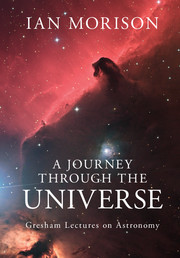Book contents
- Frontmatter
- Dedication
- Contents
- Preface
- Acknowledgements
- 1 Watchers of the skies
- 2 Our Sun
- 3 Aspects of our Solar System
- 4 The rocky planets
- 5 The hunt for Planet X
- 6 Voyages to the outer planets
- 7 Harbingers of doom
- 8 Impact!
- 9 Four hundred years of the telescope
- 10 The family of stars
- 11 Aging stars
- 12 The search for other worlds
- 13 Are we alone? The search for life beyond the Earth
- 14 Our island Universe
- 15 Wonders of the southern sky
- 16 Proving Einstein right
- 17 Black holes: no need to be afraid
- 18 It’s about time
- 19 Hubble’s heritage: the astronomer and the telescope that honours his name
- 20 The violent Universe
- 21 The invisible Universe: dark matter and dark energy
- 22 The afterglow of creation
- 23 To infinity and beyond: a view of the cosmos
- Index
- Plate section
- References
23 - To infinity and beyond: a view of the cosmos
Published online by Cambridge University Press: 05 October 2014
- Frontmatter
- Dedication
- Contents
- Preface
- Acknowledgements
- 1 Watchers of the skies
- 2 Our Sun
- 3 Aspects of our Solar System
- 4 The rocky planets
- 5 The hunt for Planet X
- 6 Voyages to the outer planets
- 7 Harbingers of doom
- 8 Impact!
- 9 Four hundred years of the telescope
- 10 The family of stars
- 11 Aging stars
- 12 The search for other worlds
- 13 Are we alone? The search for life beyond the Earth
- 14 Our island Universe
- 15 Wonders of the southern sky
- 16 Proving Einstein right
- 17 Black holes: no need to be afraid
- 18 It’s about time
- 19 Hubble’s heritage: the astronomer and the telescope that honours his name
- 20 The violent Universe
- 21 The invisible Universe: dark matter and dark energy
- 22 The afterglow of creation
- 23 To infinity and beyond: a view of the cosmos
- Index
- Plate section
- References
Summary
Modern cosmology arose from Einstein’s General Theory of Relativity, which is essentially a theory of gravity. As gravity was the only force of infinite range that could act on neutral matter, Einstein realised that the Universe as a whole must obey its laws. He was led to believe that the Universe is ‘static’, or unchanging with time, and this caused him a real problem as gravity, being an attractive force, would naturally cause stationary objects in space to collapse down to one point. To overcome this he had to introduce a term into his equation that he called the cosmological constant, Lambda or Λ. This represents a form of antigravity that has the interesting property that its effects become greater with distance. So, with one force decreasing and the second increasing with distance it was possible to produce a static solution. He later realised that this was an unstable situation, and that a static universe was not possible, calling this ‘the greatest blunder of his life’. He could have predicted that the Universe must be either expanding or contracting. However, as we will see, perhaps he was not quite as wrong as he thought.
Big Bang models of the Universe
A Russian meteorologist, A. A. Friedmann, solved Einstein’s equations to produce a set of models in which the Universe expanded from a point, or singularity. These were given the name ‘Big Bang’ models by Fred Hoyle – some say that this was meant to be a disparaging term as Hoyle was an advocate of another theory, the Steady State theory, to be discussed below, and he did not like them. In all of these models, the initially fast rate of expansion is slowed by the attractive gravitational force between the matter of the Universe. If the density of matter within the Universe exceeded a critical amount, it would be sufficient to cause the expansion to cease and then the Universe would collapse down to a ‘Big Crunch’ (these are called closed universes). If the actual density were less than the critical density, the Universe would expand for ever (called open universes). In the critical case that is the boundary between the open and closed universes, the rate of expansion would fall to zero after infinite time (called the ‘flat’ or ‘critical’ universe).
Information
- Type
- Chapter
- Information
- A Journey through the UniverseGresham Lectures on Astronomy, pp. 336 - 346Publisher: Cambridge University PressPrint publication year: 2014
